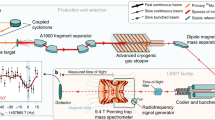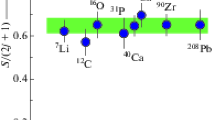Abstract
The accuracy of the SMILETRAP mass spectrometer has been verified by a number of mass comparisons involving well-known masses. Our results for H2 +,Ne6+,Ne9+ ,10+,Si12+ ,13+ ,14+,and Ar14+ ,16+ all agree within the statistical errors (0.3–1 ppb) with previous determinations. However, all measurements involving He give a deviation. The combined He1+,2+ data results in a mass deviation of +1.9 ±0.23 ppb. The uncertainty of the accepted He mass is 0.25 ppb, thus this represents a significant deviation. High statistics comparisons (statistical uncertainty <0.5 × 10-9utilizing different species (excluding He) and charge states agree within ±0.5 ppb. An analysis estimating the contribution from individual systematic error sources and other auxiliary tests does not allow a systematic error larger than ± 0.85 ppb. We conclude that for now we cannot rule out the presence of an unknown systematic error which in the He comparison results in a near 2 ppb deviation. Thus, as a safety measure we should exclude the He data when calculating the proton mass. The He discrepancy also forces us to give a larger limit of the systematic error of the proton mass than motivated by high statistics comparisons. However, due to the consistency of all other measurements and tests, it appears unlikely that this deviation should be present to the same extent in other comparisons. Thus, for now, after a preliminary analysis we report a proton mass = 1.007 276 466 72 ± 16 ± 85 u, where the errors are the weighted statistical errors and the estimated maximal systematical error, respectively. After a complete analysis we expect the systematic error to be reduced below ±0.5 ppb.
Similar content being viewed by others
References
G. Audi and A.H. Wapstra, Nucl. Phys. A 565 (1993) 1; G. Audi and A.H. Wapstra, Nucl. Phys. A 595 (1995) 409.
V. Natharajan, K.R. Boyce, F. Di Filippo and D.E. Pritchard, Phys. Rev. 71 (1993) 1998; F. Di Filippo, V. Natarajan, K.R. Boyce and D.E. Pritchard, Phys. Rev. Lett. 73 (1994) 1481; F. Di Filippo, V. Natarajan, M. Bradley, F. Palmer and D.E. Pritchard, Phys. Scripta 59 (1995) 144; M. Bradley, F. Palmer, D. Garrison, L. Ilich, S. Rusinkiewicz and D.E. Pritchard, Hyp. Interact. 108 (1997) 227.
L. Brown and G. Gabrielse, Rev. Mod. Phys. 58 (1986) 233.
C. Carlberg et al., Phys. Scripta 59 (1995) 196; C. Carlberg et al., Phys. Scripta 73 (1997) 347.
G. Bollen and the Isoltrap Collaboration, Phys. Scripta 59 (1995) 165; G. Bollen et al., Nucl. Instrum. Methods A 368 (1996) 675.
E. Beebe, L. Liljeby, Å. Engström and M. Björkhage, Phys. Scripta 47 (1993) 470; E.D. Donets, Phys. Scripta 71 (1997) 5; H. Borgenstrand et al., Phys. Scripta 71 (1997) 88.
R.S. Van Dyck, Jr., P.B. Schwinberg and H.G. Dehmelt, Phys. Rev. D 34 (1986) 722; Phys. Rev. Lett. 59 (1987) 26; R.S. Van Dyck, Jr., F.L. Moore, D.L. Farnham and P.B. Schwinberg, Int. J. Mass. Spectr. Ion Phys. 66 (1985) 327; Bull. A. Phys. Soc. 31 (1986) 244; R.S. Van Dyck, Jr., D.L. Farnham and P.B. Schwinberg, Phys. Scripta 46 (1992) 257; Phys. Rev. Lett. 70 (1993) 2888.
G. Gabrielse et al., Phys. Rev. Lett. 65 (1990) 1317; G. Gabrielse et al., Phys. Rev. Lett. 74 (1995) 3544; D. Phillips et al., Phys. Scripta 59 (1995) 307.
G. Gräff, H. Kalinowsky and J. Traut, Z. Phys. A 297 (1980) 35; G. Gärtner and E. Klempt, Z. Phys. A 287 (1978) 1.
H. Borgenstrand, Thesis, Stockholm University (1997).
R.S. Van Dyck, Jr., D.L. Farnham and P.B. Schwinberg, Phys. Scripta 59 (1995) 134.
Kelly, hysical and Chemical Reference Data, Vol. 16,suppl. 1 (1987).
Y. Weijun, R. Alheit and G. Werth, Z. Phys. D 28 (1993) 87.
G. Dunn, Phys. Rev. 172 (1968) 1.
F. von Busch and G. Dunn, Phys. Rev. A 5 (1972) 1726.
J. Kern, T. Engel, D. Hagena and G. Werth, Phys. Scripta 45 (1992) 575; C. Gerz, D. Wilsdorf and G. Werth, Nucl. Instrum. Methods B 47 (1990) 453; S. Brunner, T. Engel and G. Werth, Meas. Sci. Technol. 6 (1995) 222.
R.S. Van Dyck, F.L. Moore, D.L. Farnham and P.B. Schwinberg, Phys. Rev. A 40 (1989) 6308; R.S. Van Dyck, Jr. and P.B. Schwinberg, Phys. Rev. Lett. 47 (1981) 395.
G. Bollen et al., Phys. Rev. C 46 (1992) R2140.
A. Müller, N. Djurić, G.H. Dunn and D.S. Belić, Rev. Sci. Instrum. 57 (1986) 349.
S. Brunner, Thesis, Johannes-Gutenberg Universität (1995).
Rights and permissions
About this article
Cite this article
Carlberg, C. Mass measurements of few-electron systems in Penning traps. Hyperfine Interactions 114, 177–195 (1998). https://doi.org/10.1023/A:1012630707185
Issue Date:
DOI: https://doi.org/10.1023/A:1012630707185




